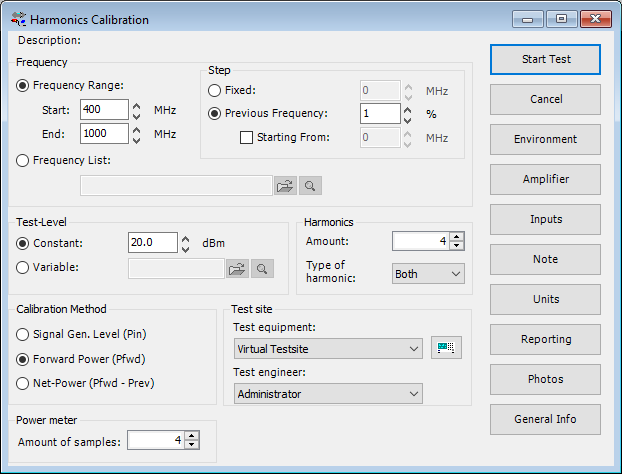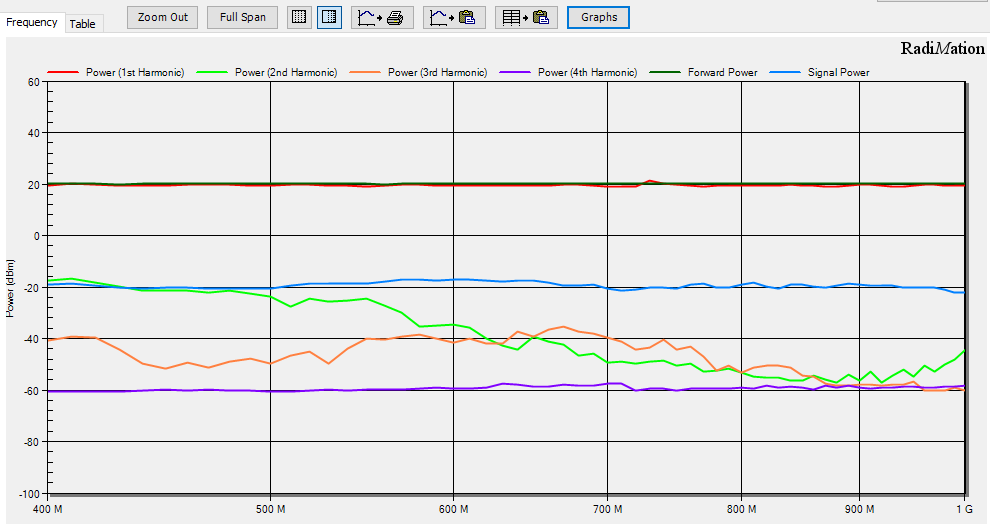How to measure amplifier harmonics using RadiMation[edit]
This application note explains how RadiMation® can be used to perform accurate measurement of the harmonics that are generated by an amplifier.
The measurement of the harmonics is often needed to ensure that the used amplifier in the amplifier setup is not generating too much power on multiples of the carrier frequency.
The first harmonic is the same as the generated CW signal which is the input signal for the amplifier. The second harmonic is present at 2x the CW frequency. The third harmonic is present at 3x the CW frequency, and so on.
As the harmonics are thus present on higher frequencies than the CW signal, all the equipment that is connected to the output of the amplifier up to and including the used spectrum analyser should be able to be used on those higher frequencies. For an amplifier of 80 MHz - 1000 MHz, measuring up to the 6th harmonic, it is thus necessary that the measurement equipment is usable up to 6 GHz.
Overview[edit]
There are two possible setups of the used equipment to measure amplifier harmonics.
- Measure the initial power on the first harmonic and the additional harmonics with a spectrum analyser.
- Measure the initial power with a broadband power meter and measure the harmonics with a spectrum analyser.
A schema of the test setup:
File:Harmonics schematic.png
For the 'Load' an actual high power RF load can be used, or it can also be the normally to be used intended equipment, like for example the antenna in an anechoic chamber.
The coupler, splitter, cables and spectrum analyser should be able to be used for the highest frequency of the harmonics that are being measured.
Configuring the testsite[edit]
Using a spectrum analyser[edit]
To use only the spectrum analyser we need to configure the the Forward power meter to be the spectrum analyser device driver in the testsite.
Keep in mind to not select any device for the sensor power meter on the second tab.
| Device name |
Tab in testsite configuration window |
note
|
| Signal Generator |
Devices 1 |
|
| Amplifier |
Devices 1 |
This is the amplifier of which the harmonics are being measured.
|
| Coupler |
Devices 1 |
This device should allow to be used at the highest frequency of the measured frequencies.
|
| Forward power meter |
Devices 1 |
The powermeter device driver for the analyser that is being used to measure the harmonics. This device should allow to be used at the highest frequency of the measured frequencies,
|
| Antenna |
Devices 1 |
|
Using a broadband powermeter and a spectrum analyser[edit]
When using the powermeter to setup the required testlevel and a spectrum analyser to measure the harmonics we need to setup the forward power meter to the power meter and on the devices 2 tab we select the spectrum analyser.
File:Harmonics Configure Broadband power meter.PNG
File:Harmonics Configure Spectrum Analyser as Sensor Power meter.PNG
Configuring the calibration[edit]
To start the harmonics calibration first, open an EUT file and select from the menu:
-
 Calibration
Calibration
-
 EUT Calibration
EUT Calibration
-
 Harmonics
Harmonics
The configuration window for the harmonics calibration will be shown, which allows to configure all the parameters.

 Description Description
|
The name of the selected TSF file.
|
 Frequency Range Frequency Range
|
Sets the frequency specification to a frequency range.
|
 Start Start
|
Sets start frequency.
|
 End End
|
Sets end frequency.
|
 Step Fixed Step Fixed
|
Sets a fixed step size from start to end frequency.
|
 Step Previous Frequency Step Previous Frequency
|
Sets a logarithmic step size from start to stop frequency
|
 Starting From Starting From
|
Sets the start frequency for a logarithmic step from which the actual measurement frequencies will be calculated. the starting from frequency should be lower then the actual start frequency. The test will start at the first calculated frequency that is equal or higher then the specified start frequency.
|
 Frequency list Frequency list
|
With frequency list the operator can select a frequency list file by browsing to the file location. The frequencies inside the frequency list file will be measured.
|
 Constant Constant
|
The test level can be set to a constant level to which the power should be regulated.
|
 Variable Variable
|
A .COR file can also be used. This can be the same file as for the Frequency List.
|
 Amount Amount
|
The number of harmonics that should be measured.
|
 Type of harmonic Type of harmonic
|
If only the even, odd or both (even and odd) harmonics should be measured.
|
 Calibration method Calibration method
|
On which power levelling point the desired testlevel should be regulated.
|
 Test Equipment Test Equipment
|
In the test site window the test engineer can select which equipment list will be used during this test.
|
 Test engineer Test engineer
|
In the test engineer window, the test engineer can select its own name. The test engineer name will be stored by the test results
|
 Amount of samples Amount of samples
|
The amount of measurements that are measured on each harmonic to determine its power. The average of these measurements will be used as the power of the harmonic.
|
 Start Test Start Test
|
Starts the configured calibration.
|
 Cancel Cancel
|
Cancel the configured calibration.
|
 Environment Environment
|
Display the environment window.
|
 Amplifier Amplifier
|
|
 Inputs Inputs
|
|
 Note Note
|
Display the note window.
|
 Units Units
|
Display the Units configuration window
|
 Reporting Reporting
|
|
 Photos Photos
|
|
 Genaral info Genaral info
|
|
Test results[edit]
In the test results it is possible to show the forward power measured.
When only a spectrum analyser is used, the forward power will be the same as the first harmonic. When also a broadband power meter is used, the forward power measurement will be the measured broadband power, and it thus will be higher than the power of the first harmonic alone.

In the results overview of the amplifier harmonics EUT calibration the following measurement values are available in the graph and the table:
 Signal power Signal power
|
The power of the signal generator that is driving the amplifier.
|
 Forward power Forward power
|
The (broadband) output power that is generated by the amplifier.
|
 Power (1st harmonic) Power (1st harmonic)
|
The power of the first harmonic (the actual CW frequency) that is generated by the amplifier.
|
 Power (...th harmonic) Power (...th harmonic)
|
The power of specified harmonic that is generated by the amplifier.
|
 Gain (...th harmonic) Gain (...th harmonic)
|
The dBc difference between the specified harmonic and the first harmonic.
|
 Std. Dev. (...th harmonic) Std. Dev. (...th harmonic)
|
The standard deviation of the measured power samples of the specified harmonic.
|
All the values of the harmonics are shown relative to the applied CW frequency that was generated by the signal generator when the harmonic was measured. If for example a CW frequency of 500 MHz is generated, the power value of the 3rd harmonic is also shown in the table at 500 MHz, even though it was actually measured on 1500 MHz. Showing the measured values of the harmonics on the same frequency as the CW frequency simplifies the comparison of the values between the harmonics and the value of the 1st harmonic itself.
It is possible that one or more of the higher harmonics have not been measured due to limitations of the allowed frequency range of the used equipment (which can be powermeter, coupler, spectrum analyzer, antenna and cables). For a CW frequency of 500 MHz, the 5th harmonic is generated at 2500 MHz. If however the used spectrum analyzer is only able to measure up to 2000 MHz, it is not possible to measure the 5th harmonic of 500 MHz, and thus the value in the table will be empty. Also the graphline of the 5th harmonic will then only be drawn up to 400 MHz, which corresponds to the 5th harmonic at 2000 MHz, which is the highest measurable frequency of that spectrum analyzer.
For more information on how to perform the measurement of amplifier harmonics, please see the EUT Harmonics section in Chapter 12 of the RadiMation® manual.
 Calibration
Calibration
 EUT Calibration
EUT Calibration
 Harmonics
Harmonics 
